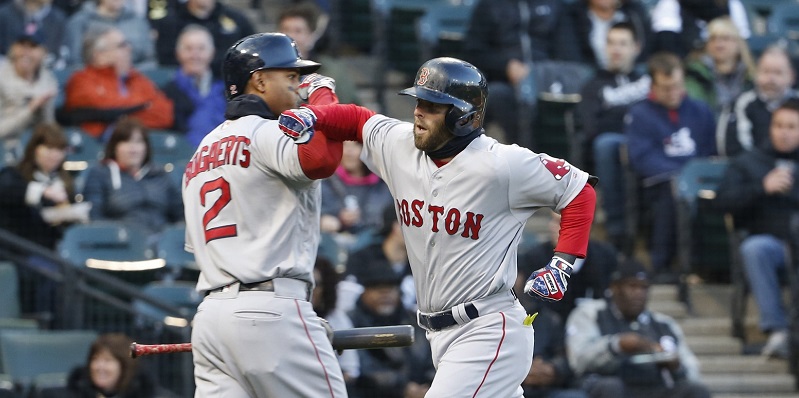The Red Sox have done many of things well since the turn of the century. They’ve won a lot of games (save for those three last-place finishes), developed some good prospects and have scored countless times in both the trade and free agent market. It’s made for an impressive, and fun run that’s included championships and given us many memories.
One thing the Red Sox have done consistently well over this stretch is show tremendous plate discipline. Some of their best teams have had a knack wearing pitchers down, drawing walks and being really hard to strike out. The latter point is perhaps most intriguing. Since 2003, aka the David Ortiz era, the Red Sox have been one of the hardest teams to strike out, finishing in the top half of the majors in strikeout rate only three times in that 13-year span. It’s no coincidence that they’ve also been consistently one of the better offensive teams in the game.
This year’s team has been a continuation of that. Entering Sunday, the Red Sox held the third-lowest strikeout rate in the majors at 17.8 percent. Three of their players are in the top 25 (or bottom, depending on how you view the numbers) in strikeout rate, while seven of their everyday guys strike out at a rate lower than 20 percent. Simply put, the Red Sox are a difficult team to strikeout. They’ve also had one of their best offensive seasons ever. Not all successful lineups have to be hard to strike out. The 2013 Red Sox struck out at a 20.5 percent rate, which was good for ninth-highest in baseball. But it’s another element to what has made the 2016 lineup so dangerous.
The Red Sox have the highest contact rate in the majors (81.9 percent), and have five players with Z-Contact percentages of 87 percent or higher.
The Red Sox’s low strikeout rate can be attributed to a number of factors. One of them is the team’s patient approach at the plate. According to baseball reference, the Red Sox average 3.91 pitches per plate appearance, tying them for eighth in the majors. That patience is leading to more bases as they’re walking at baseball’s seventh-best rate (8.8 percent).
An even greater factor is the Sox’s ability to make contact. The Red Sox have the highest contact rate in the majors (81.9 percent), and have five players with Z-Contact percentages of 87 percent or higher. Three of those players sit above 90 percent. But it’s not just the everyday players. Sandy Leon, Blake Swihart and Christian Vazquez, all of whom have played portions of the season with the Red Sox, have made contact on pitches inside the zone at 88 to 91 percent rates. The Sox are making contact and pitchers are failing to strike out their hitters regardless of who they send to the plate. Those numbers are especially impressive when you consider the majority of the lineup consists of players in their first three major league seasons. Which brings me to my next point.
The Red Sox have shown a knack for developing prospects into patient players with good contact rates over the past decade and a half. Two prime examples are former Sox stars Jacoby Ellsbury and Kevin Youkilis. Youkilis struck out at an ok 18.7 percent rate for his career, but also made contact at an 83.2 percent rate. Ellsbury, meanwhile, has been among the best when it comes to fitting that bill, owning a 13.5 percent strikeout rate and 87.2 percent contact rate for his career.
Those two were part of a past generation of Red Sox stars. That was the generation in which Ortiz and Dustin Pedroia were the faces of the franchise. The latter two’s time in that role is fading away, but their ability to embody that approach hasn’t changed. Pedroia has the 14th-lowest strikeout rate in the majors at 12 percent, while Ortiz’s 11.9 percent mark is 13th-lowest. Both in turn make regular contact.
| Contact | Z-Contact | O-Contact | |
| Dustin Pedroia | 88.5 percent | 90.2 percent | 81.3 percent |
| David Ortiz | 83.3 percent | 87.6 percent | 65.6 percent |
Now these traits can be seen in the next generation of Red Sox players, particularly cornerstones Mookie Betts and Xander Bogaerts. Betts and Bogaerts hold strikeout rates of 13.1 percent and 14.8 percent, respectively, while their contact numbers compare nicely to those of Pedroia and Ortiz.
| Contact | Z-Contact | O-Contact | |
| Mookie Betts | 87.1 percent | 95.9 percent | 64.9 percent |
| Xander Bogaerts | 82.5 percent | 89.9 percent | 65.2 percent |
They are the type of players who aren’t likely to swing and miss. According to Brooks Baseball, Betts’ whiff/swing rate against fastballs sits at 8 percent, while Bogaerts is 11 percent. The numbers are indicative of the type of hitters both players are, but it also exemplifies the way the Red Sox have continued to develop their prospects. Theo Epstein once said plate discipline is “something you’re born with,” but at the very least it’s something Epstein sought in players during his time in Boston (Bogaerts and Betts are, of course, Epstein guys) and has continued to manifest itself with this generation of Red Sox.
Betts and Bogaerts share the short swing, quick hands and elite bat speed that makes for good contact hitters. It’s the type of qualities the likes of Ortiz, Pedroia and even Manny Ramirez shared. It’s also a reminder that this philosophy of working the count, making contact and being difficult to strike out isn’t leaving Boston any time soon. These type of players live within the depths of the Red Sox’s organization, which is a good sign for the future of the club offensively.
Photo by Kamil Krzaczynski/USA Today Sports Images
